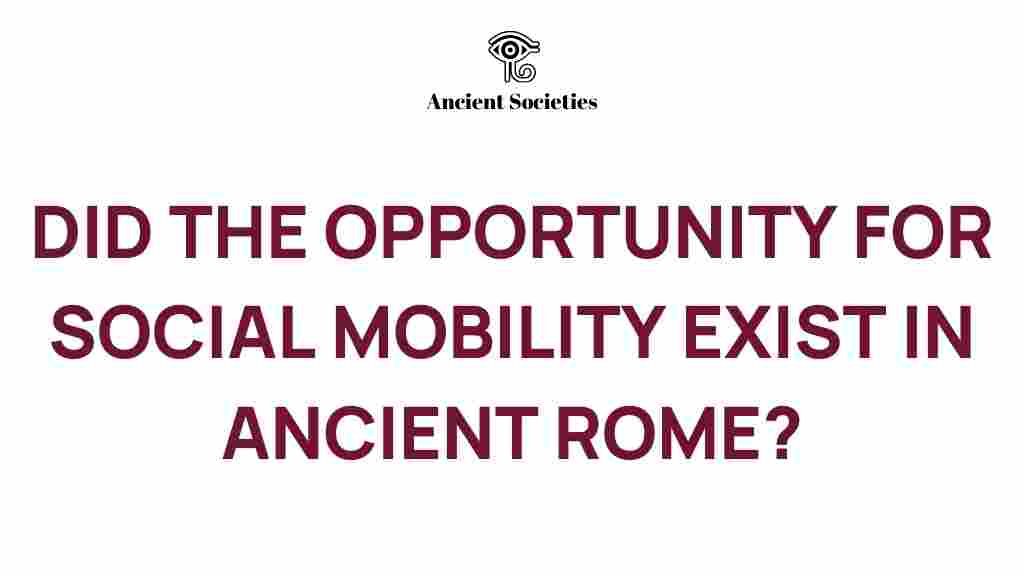Unveiling Social Mobility: Was It Possible in Ancient Rome?
Social mobility has always been a topic of great interest and debate, especially when examining historical societies. In Ancient Rome, the class structure was intricate and rigid, yet hints of opportunity existed for those who sought to change their societal standing. This article explores the concept of social mobility within the framework of Ancient Rome, analyzing the class structure, societal change, and the various avenues through which wealth and citizenship could alter one’s position within the Roman social hierarchy.
The Class Structure of Ancient Rome
The Roman society was characterized by a well-defined class structure, which can be broadly categorized into several tiers:
- Patricians: The elite class, comprising wealthy landowners and nobles.
- Equestrians: Wealthy citizens who were not part of the aristocracy, often involved in trade and business.
- Plebeians: The common people, including farmers, artisans, and laborers.
- Freedmen: Former slaves who had gained their freedom, often working in various trades.
- Slaves: Individuals who had no rights and were considered property.
Each class had its own privileges and restrictions, which played a crucial role in determining the opportunities available for social mobility. While the patricians held significant power, the rise of the equestrian class indicated that wealth could sometimes transcend traditional barriers.
The Role of Wealth in Social Mobility
In Ancient Rome, wealth served as a powerful tool for social mobility. Accumulating wealth allowed individuals to gain influence and opportunities that might otherwise be inaccessible. Wealthy plebeians could purchase land, which not only increased their economic status but also their social standing. This transition from plebeian to equestrian was a pathway to greater influence in Roman society.
Wealth also facilitated access to citizenship, which was a crucial factor for social mobility. Citizenship offered legal rights and privileges, including the ability to participate in politics and own property. Some methods through which individuals could gain citizenship included:
- Military Service: Serving in the Roman army could lead to citizenship, especially for auxiliaries.
- Manumission: Freed slaves could become citizens, providing a pathway for social advancement.
- Special Grants: The emperor could grant citizenship, often as a reward for service or loyalty.
Societal Change and Its Impact on Social Mobility
Throughout Roman history, societal change played a significant role in altering the dynamics of social mobility. Major events, such as the Social Wars, highlighted the demand for greater inclusion of the Italian allies into the Roman citizenship fold, reflecting a shift in the rigid class structure.
The expansion of the Roman Empire also contributed to societal change. As territories were conquered, new populations were integrated into the Empire, leading to a more diverse social fabric. This integration often came with the offer of citizenship, further blurring the lines of social hierarchy.
Opportunities for Social Mobility in Ancient Rome
Despite the strict social hierarchy, various opportunities existed for individuals seeking upward mobility:
- Political Offices: The cursus honorum, or course of honors, allowed wealthy plebeians to ascend to political roles, providing a platform for influence.
- Education: Access to education enabled individuals to acquire skills in rhetoric, law, and governance, which were essential for political and social advancement.
- Marriage Alliances: Strategic marriages could elevate one’s status and ensure access to elite circles.
Challenges and Limitations to Social Mobility
While opportunities existed, several challenges and limitations hindered social mobility in Ancient Rome:
- Prejudice: Deep-seated biases against certain classes, especially towards plebeians and freedmen, often limited their acceptance in elite circles.
- Legal Restrictions: Laws sometimes restricted the rights of lower classes, making it difficult for them to acquire property or hold certain offices.
- Economic Barriers: The initial lack of wealth could be a significant obstacle, as starting from a lower class meant limited resources for education and political engagement.
Step-by-Step Process of Achieving Social Mobility
For those in Ancient Rome seeking to improve their social standing, a structured approach could enhance their chances:
- Identify Opportunities: Look for avenues such as military service or trade that could lead to wealth accumulation.
- Invest in Education: Acquire knowledge and skills that are valued in Roman society, particularly in law and rhetoric.
- Network Strategically: Build relationships with influential individuals through social gatherings and public events.
- Consider Marriage: Explore marriage alliances with families of higher status to enhance social standing.
- Engage Politically: Pursue political positions that could further increase visibility and influence.
Troubleshooting Tips for Aspiring Individuals
While the journey towards social mobility in Ancient Rome was fraught with challenges, individuals could navigate potential setbacks by:
- Seeking Mentors: Find experienced individuals who can provide guidance and support in navigating social structures.
- Staying Informed: Keep abreast of political changes and societal trends that may present new opportunities.
- Building a Reputation: Cultivate a reputation for excellence in one’s field, whether in business, military, or politics.
Conclusion: The Complexity of Social Mobility in Ancient Rome
In conclusion, while social mobility in Ancient Rome was limited by a rigid class structure, opportunities did exist for those willing to pursue them. Wealth, education, and strategic relationships could enable individuals to transcend their social standings. The interactions between wealth, citizenship, and societal change paint a complex picture of the potential for social mobility in Ancient Rome.
Understanding the dynamics of Roman history provides valuable insights into how class structures can evolve and how societal change can create new opportunities. Although social mobility was often constrained, the stories of those who navigated the challenges serve as a testament to human ambition and adaptability.
To learn more about the intricacies of social structures in historical contexts, you can explore further at this resource.
This article is in the category Society and created by AncientSocieties Team
